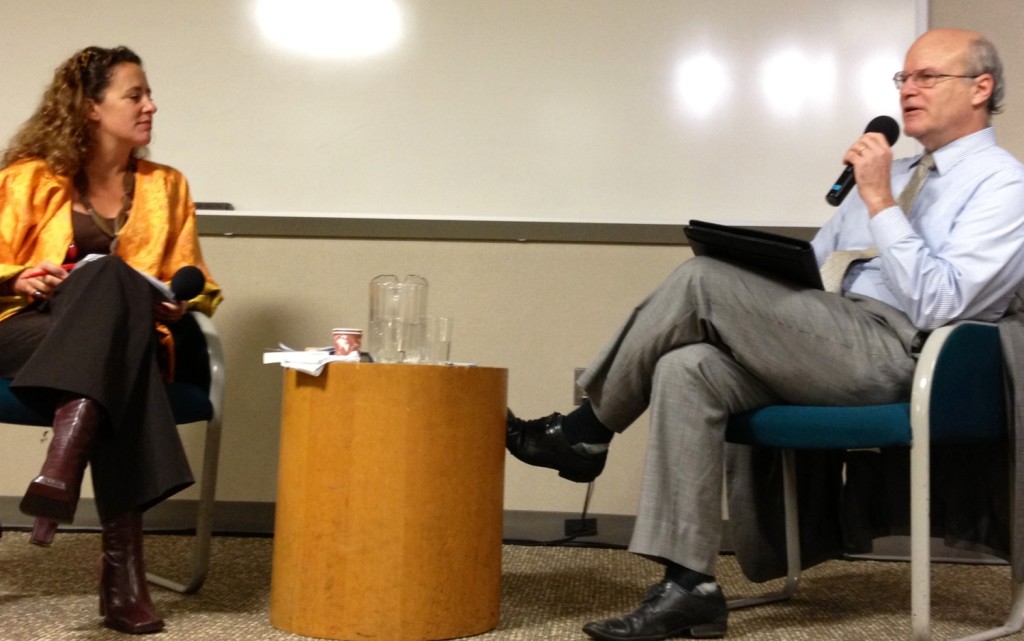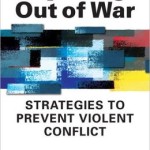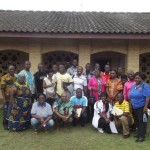Peacebuilding and Development: The Virtuous Circle
By Donald Steinberg, President of World Learning
Don Steinberg was the special guest speaker at October’s Conflict Prevention & Resolution Forum in Washington DC, moderated by Sandra Melone of Search. He is the former Deputy Administrator at USAID and a former Ambassador to Angola.
“The U.S. will join with our allies to eradicate extreme poverty in the next two decades: by connecting more people to the global economy; by empowering women; by giving our young and brightest minds new opportunities to serve; by helping communities to feed, power, and educate themselves; by saving the world’s children from preventable deaths; and by realizing the promise of an AIDS-free generation.” ~President Obama’s State of the Union address:
These words are inspirational, but they are not a pipe-dream. Working together, we have brought 600 million people across the poverty line in the last decade and a half. We have reduced infant and maternal mortality by a third. More students, especially girls, are getting quality educations in school than ever before. Reportedly, Google has set aside money to build a poverty museum, because the expectation is that by 2035, the only place you could see extreme poverty will be in a museum.
But we cannot achieve these objectives without peace and rule of law. Armed conflict is a development destroyer. Literally decades of painstaking efforts to build good governance, ensure physical security, and address the challenges of human security in health, education, housing, nutrition, can be wiped out within weeks as soon as the guns start blazing. It is reported that not a single Millennium Development Goal has been met in a fragile and conflict state.
There are natural linkages between development and stability, and no place demonstrates that linkage better than Afghanistan. The far-from-perfect peace in Afghanistan has permitted momentous improvements in socio-economic and humanitarian conditions. Afghanistan has achieved one of the fastest growth rates in the world since the Taliban’s fall. Infant and maternal mortality rates have plummeted by nearly two-thirds, along with similar achievements in other health and socio-economic indicators. As a result, life expectancy has increased by 15 to 20 years in little more than a decade – from 47 years when the Taliban was in control to 62 years or more today.
For women and girls, the changes are even more remarkable. Today, three million Afghan girls are in school, in contrast to none when the Taliban ruled. Last year, some 120,000 girls graduated from high school; 40,000 young women are in university; and the percentage of women in the Afghan parliament (25 percent) is greater than in the U.S. Congress.
The question is whether these achievements will be matched by progress in the political and security arenas, and whether they can survive the withdrawal of international combat forces. Will the achievements of women in particular be sacrificed on the altar of a false peace with the Taliban? Part of the answer to that question depends on whether they are going to have international support for their transition. It will be harder for spoilers to win the hearts and minds of the Afghan people if there is a continuing “peace dividend.”
By contrast, the landscape is less promising in other regions. In the Sahel, resource conflicts, poverty, international migration, climate change, extremism and governance deficits come together in a witches’ brew that threatens not only those countries, but countries and people around the world. In Central America and Central Africa alike, the end of formal conflict in recent years has led to an even more pernicious pattern of death and suffering from criminal violence, domestic violence, and sexual violence — the key word here is “violence” — that has killed more people than the war itself.
There is a growing international recognition of the connection between development and stable and just states. The New Deal for Engagement in Fragile States established a very clear link between development and conflict. This is a promising development. Two years ago, I led the U.S. government delegation to a U.N. conference in Istanbul on the least developed countries. Based on pre-conference consultations, I wasn’t allowed to even mention the word “fragility” as a factor in continuing poverty in least developed countries. Now, dozens of countries are self-identifying as “fragile,” and calling for special treatment as a result.
What does this mean for our efforts? If we are going to respond to conflict through development, or more importantly, if we are going to seek to forestall or defuse conflict around the world, we need to know where to focus. So where and how does conflict originate?
Seven Deadly Synergies
At the risk of over-simplification, I want to draw from my own background and the research done at World Learning. I can summarize my own experience and research into seven factors which, when they come together, can build more dangerous tensions than the sum of their parts. I call these the “Seven Deadly Synergies.”
- Rapid urbanization and population pressure coupled with weak economies. One of the quickest routes to conflict is when the potential demographic dividend from a large youth population gets transformed into dangerous youth bulge. Young people who do not see opportunities for positive contributions within their societies, are more susceptible to fanatics and zealots.
- Lack of political participation, responsive governance, and rule of law. Societies must have safety valves to permit the peaceful redress of grievances.
- The absence of institutions of civil society that draw populations together across potentially divisive religious, ethnic, class, regional, and political lines. Having multiple identities such as journalists, women, academics, lawyers, etc., tends to emphasize the centripetal forces at play in societies
- “Location, location, location,” the role of neighbors in either mediating or fueling disputes is fundamental. Countries in bad neighborhoods risk spill-over from armed combatants, refugees and arms flows; those in good neighborhoods receive a powerful dampening effect on political and potential violence.
- The degree to which the society is militarized or, put another way, whether there has been a “normalization of violence.” Are human interactions carried out and normal conflict resolved in the presence of a gun? Factors at play here include the role of military and security forces in political structures and the proliferation of small arms and light weapons.
- The extent to which the society is closed, especially to international influences. Closed political systems, economies, and media environment are dangerous. Conflicts are like mushrooms: they grow best in darkness.
- The final factor is something you hear about in investment perspectives. Except that in this case, past record is an indicator of future performance. The single most reliable determinant as to whether conflict is going to emerge in a society is whether there has been conflict in the last 10 to 15 years.
So, if these seven factors are the ones we are focused on, what does this mean for our efforts?
Interlocking Challenges for Successful Peace Building
Throughout the conflict prevention and peace building community, we have all studied dozens of successful and failed peacekeeping and peace building efforts since World War II. We have found that five key challenges must be addressed nearly simultaneously in order to build peace and justice. These are restoring security and stability, building a political framework, kick-starting the economy, establishing a sense of justice and accountability for past abuses, and promoting civil society.
Security: In post-conflict societies, the international community tends to rely on the security blanket of international peacekeepers. Indeed, the 100,000 or so U.N. peacekeepers and lesser numbers of other regional peacekeepers can provide a buffer. But, as soon as possible credible local security forces must take over to provide a sense of stability, normalcy and rule of law to everyday life. International support for security sector reform is key to ensuring that forces are well-trained, disciplined, and adequately paid so that they do not exploit and abuse the populations they are supposed to protect.
There must be effective programs for disarmament, demobilization, and reintegration, and we need in particular to address the tragic phenomenon of child soldiers. Children must be permitted to put down their AK-47s and pick up schoolbooks.
Governance: The second challenge is to restore legitimate political frameworks. Confidence in government must exist at national and local levels; armed movements must be transformed into political parties; and effective legislatures and judiciaries must be restored to counter-balance the power of the executive. A culture of accountability is necessary along with an effective system to protect human rights. Decentralization and empowerment of provincial and local institutions is essential but it also has to be balanced against the need for central authorities to take tough steps to rein in regional warlords and other recidivist actors.
Development: Third is the question of economic renewal. We can define this in two ways. First is the physical reconstruction of damage from the conflict: the rebuilding of roads, clinics, schools, power grids, and houses. At the same time, the challenge of reviving agriculture, creating conditions needed to attract local and foreign investment, and ensuring job creation must be addressed in order to build popular support for the benefits of peace. Again, it is no surprise that in countries that have 90 percent youth unemployment, renegade leaders like Foday Sankoh in Sierra Leone, Joseph Kony in Uganda, and Jonas Savimbi in Angola could lure or kidnap disaffected youth with a siren song that offers quick, if venal, empowerment and meaning to their lives.
Growth must be inclusive. It is not enough to ensure high economic growth rates. Given the depressed state of the economy in most countries coming out of conflict, high growth rates are relatively easy to achieve. But growth has to be evenly distributed; it has to create jobs; it has to be free from corruption; and it has to result in improved housing, health care and education. Countries affected by the Arab Spring achieved rapid growth rates of up to ten percent. But jobs were not created. Economic benefits were badly distributed, subject to corruption and did not create socio-economic advancements. The result was a social revolution – a revolution that I believe was absolutely necessary but one that comes at great cost.
Transitional Justice: The fourth challenge is coming to grips with past abuses and atrocities. Nations and individuals who have suffered grievous treatment must balance immediate accountability and long-term national reconciliation. Too frequently the urge is to try and forget the past, but that generally doesn’t work. Transitional justice addressed through generous amnesties means that men with guns forgive other men with guns for crimes committed against women and children in the conflict.
There is no “one-size-fits-all” approach to transitional justice. Whether it is action by local courts, the International Criminal Court, a truth and reconciliation commission, the gacaca community court system in Rwanda, or ad hoc international tribunals where local courts are inadequate, ensuring accountability is essential to rebuilding the concept of rule of law and eliminating a culture of impunity.
Civil Society: The final challenge, one that is often ignored, is the re-building of civil society. Groups like Search for Common Ground and World Learning are working to develop institutions of academics and lawyers and journalists and women. This is the glue that holds society together. Put another way, it provides the safety valves that permit the peaceful redress of grievances. Such groups are frequently polarized and/or marginalized during conflict, often as a conscious effort by governments or rebels to “divide-and-rule”. Disadvantaged minorities, including IDPs and refugees, along with women, people with disabilities, the LGBT, and indigenous populations must be drawn into the mix.
Women, Peace and Security
Women are not only the primary victims of conflict, but a key to peace. I have found, throughout my career in negotiating and implementing peace agreements in half a dozen countries that, bringing women to peace tables improves the quality of the agreements reached. Involving women in post-conflict governance reduces the likelihood of a return to war.
The single best investment — to revitalize agriculture, restore health systems, and improve other social indicators after conflicts — is girls’ education. It has been said: “Educate a boy and you educate an individual; educate a girl and you educate a community.”
These issues — restoring security, building a political framework, kick-starting the economy, ensuring justice and accountability, and promoting civil society — used to be considered the “soft side” of peacebuilding. We used to draw this hard line between the physical security dimension and the human security dimension. I believe that this line has been blurred.
There is nothing soft about stopping traffickers who turn young people into commodities. There is nothing soft about preventing armed thugs from abusing people in refugee camps, or holding warlords accountable for actions against civilians, or insisting that girls’ health, education, and safety are addressed in peace negotiations and post-conflict reconstruction and reconciliation.
These are among the hardest challenges we face in international peacebuilding and international development.









